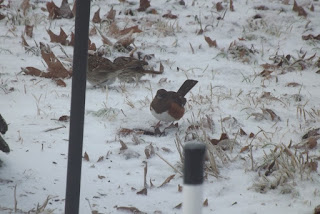The ice storm that hit during the third week of February
threw everything off-kilter for a while. The ground was crunchy (and, later, slick) with a layer of ice, the roads were impassable, tree limbs sagged, and being outdoors was tolerable for only a few minutes at a time. I had taken down the bird feeders in the backyard, mainly because I was
concerned about freezing rain coating them and clogging up their openings. If the ice rendered them unusable for the
birds, then there would be no point in keeping them up. However, my mom and I did put birdseed inside the rotting stump (mainly for the benefit of
the tree-dwelling birds) and on the frozen ground (for the shrub- and
ground-dwellers). This turned out to be
a reasonable solution, and it meant that I didn’t have to worry about continually
scraping ice off the tube feeders.
Obviously, the storm system was highly unusual for this region,
so it’s probably fair to say that it caused most of the birds and other
wildlife to struggle.
Most of the time,
birds don’t actually need the food that we put out for them; we feed birds
because of the enjoyment we get from watching their activity.
During extreme weather events, however,
feeding can sometimes help.
Seed-eating
birds, such as sparrows and finches, may have a hard time finding food after a
storm buries ground vegetation under a sheet of ice.
Insectivorous birds may have it even worse. Freezing weather kills most of their prey, making it difficult for them to find anything to eat. I was reminded of this fact just a few days into the freezing weather
event, when an Eastern Phoebe turned up dead on our front porch. The bird seemed to be extremely thin, with
its keel—the part of the sternum to which the flight muscles attach—very bony
and prominent, which makes me suspect that it starved to death. An American Robin was found on the driveway a
couple of days later, dead for the same reason, I would guess. I stored these birds in the freezer until I
could give them to the Department of Wildlife, Fisheries and Aquaculture at Mississippi
State University. They’re going to be part of
the ornithology collection.
 |
The deceased Eastern Phoebe
|
 |
The American Robin specimen -- after I'd bagged it for the freezer
|
Although some omnivorous and insectivorous birds will come to feeders for mealworms, I didn't have any of those available, and phoebes tend to feed more on flying insects than on crawling ones, anyway. I doubt that anything I could have done would have prevented the deaths of the phoebe and the robin. Other birds, however, seemed to benefit from the easy pickings in the backyard. The cold weather drew out many small groups of birds, including some species that I don't see very frequently in this area. For example, the makeshift feeding station attracted at least fifteen Fox Sparrows. On normal days, I'm lucky if I see one or two of these large, rust-colored sparrows in the neighborhood. Some of the sparrows even serenaded us with snippets of their songs.
 |
Fox Sparrows foraging with White-throated Sparrows
|
 |
Like this Fox Sparrow, most of the songbirds fluffed their feathers out in order to stay warm!
|
A couple of Rusty Blackbirds also showed up. Although I occasionally see larger flocks of this species, it isn't an especially common bird around here, either.
 |
Rusty Blackbirds -- with a Fox Sparrow in the background
|
In the fields between the creek and the end of the driveway, a few Killdeer scavenged for whatever dead insects they could find in the icy grass. I see Killdeer flying over the neighborhood on a semi-regular basis, but it's less typical of them to forage in these fields. I think that the grass is usually too high for them.
 |
Killdeer in the field
|
The other species were more common birds for this area, but they were still enjoyable to watch. Here are some photos of the avian activity in our yard:
 |
Perhaps surprisingly, Brown Thrashers came to eat the seed.
|
 |
American Goldfinches fed on the ground.
|
 |
A female Eastern Towhee showed up at one point.
|
 |
White-throated Sparrows (front) were fairly numerous, but I saw only one Song Sparrow (back).
|
 |
Northern Cardinals always put in appearances, even during foul weather.
|
 |
"Snowbird" is actually a nickname for the Dark-eyed Junco.
|
 |
Cardinals and juncos used the stump feeder.
|
 |
And Purple Finches did, too.
|
Although this event is definitely not one that I was eager to experience, I think it provided some interesting perspective—enabling me to think about ecosystems and bird communities in ways that I hadn't considered before. I'm sure that the birds appreciate the much warmer temperatures that have followed this historic event, though!
 |
Fox Sparrow seemingly enjoying the sun!
|

















No comments:
Post a Comment